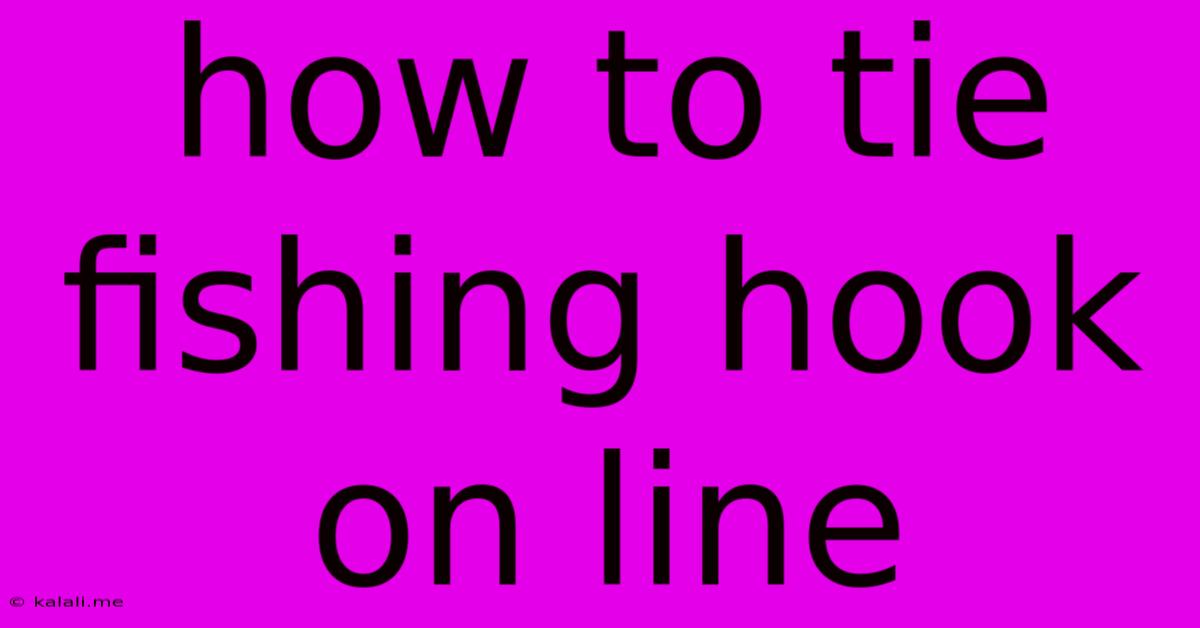How To Tie Fishing Hook On Line
Kalali
Jun 06, 2025 · 3 min read

Table of Contents
How to Tie a Fishing Hook to Your Line: A Comprehensive Guide
This guide will walk you through several popular and reliable methods for tying a fishing hook to your fishing line. Knowing how to tie a secure knot is crucial for a successful fishing trip, preventing lost catches and ensuring a smooth experience. We'll cover everything from simple knots perfect for beginners to more advanced techniques for experienced anglers. Choosing the right knot depends on the type of line, hook, and fish you're targeting.
Why is Choosing the Right Knot Important?
A poorly tied knot is the quickest way to lose a fish, or even worse, lose your expensive fishing tackle. A secure knot ensures that your hook stays firmly attached to your line, even when fighting a strong fish. The strength of the knot is directly related to the strength of your line, and using the wrong knot can significantly weaken it.
Essential Knot-Tying Tools:
While you don't need fancy tools, having a few essentials makes the process easier:
- Sharp fishing line clippers: Clean cuts prevent frayed lines.
- Good lighting: Proper visibility is key to tying a secure knot.
- Moistened fingers: This helps reduce friction and makes the line easier to manipulate.
Popular Knots for Attaching Fishing Hooks:
Here are some of the most commonly used and reliable knots for attaching fishing hooks:
1. The Improved Clinch Knot: The All-Around Favorite
This is arguably the most popular and reliable knot for tying a fishing hook to your line. It's strong, easy to learn, and suitable for most fishing situations.
Steps:
- Pass the line through the eye of the hook.
- Make several wraps (6-8) around the main line and the hook shank.
- Tuck the tag end under the first wrap, close to the hook's eye.
- Moisten the line and gently tighten the knot.
- Trim the excess tag end close to the knot.
2. The Palomar Knot: Superior Strength and Simplicity
The Palomar knot is known for its exceptional strength and ease of tying. It's a great option for heavier lines and larger hooks.
Steps:
- Double the line and pass it through the eye of the hook.
- Form a loop with the doubled line.
- Pass the hook through the loop, and then pull the loop tight against the hook's eye.
- Wet the line and carefully tighten the knot. Make sure it is tightly nestled against the eye of the hook.
- Trim the excess tag end.
3. The Uni Knot: For Monofilament and Fluorocarbon
The Uni knot is particularly effective with monofilament and fluorocarbon lines, creating a very small knot that minimizes friction and improves casting.
Steps:
- Pass the line through the eye of the hook.
- Make 5-7 turns around the main line.
- Pass the tag end back through the loop created by the first turn.
- Wet the line and gently tighten the knot.
- Trim the excess tag end.
Tips for Success:
- Practice: The best way to master these knots is to practice regularly.
- Use appropriate line: The strength of your line should match the strength of your hook and the size of the fish you're targeting.
- Wet your line: Wetting your line helps to prevent slippage and makes the knot easier to tie.
- Check your knot: Always inspect your knot before casting to ensure it's secure.
Conclusion:
Learning how to tie a fishing hook to your line is a fundamental skill for any angler. Mastering these knots will significantly improve your fishing success and enjoyment. Remember to practice, choose the right knot for your situation, and always check your knot before casting. Happy fishing!
Latest Posts
Latest Posts
-
How To Wire A 3 Prong Dryer Outlet With 4 Wires
Jun 06, 2025
-
Brake Fluid Leaking From Caliper Piston
Jun 06, 2025
-
What Is Bagsize In Random Forest
Jun 06, 2025
-
Why In Old Animes Characters Fight On Tiles
Jun 06, 2025
-
How To Remove 3m Adhesive From Wall
Jun 06, 2025
Related Post
Thank you for visiting our website which covers about How To Tie Fishing Hook On Line . We hope the information provided has been useful to you. Feel free to contact us if you have any questions or need further assistance. See you next time and don't miss to bookmark.